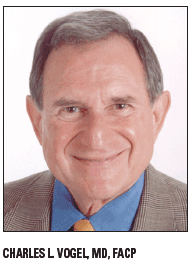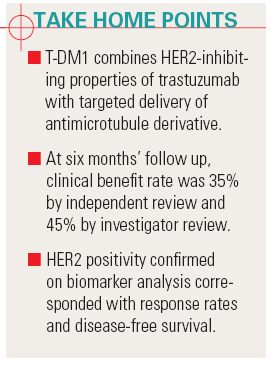Novel therapy delivers potent cytotoxin to HER2+ cells
Final results from a phase II study of an enhanced version of Herceptin upheld the emerging benefits previously seen with this novel approach in HER2-positive breast cancer.
Final results from a phase II study of an enhanced version of Herceptin upheld the emerging benefits previously seen with this novel approach in HER2-positive breast cancer.

The open-label single-arm multicenter study using trastuzumab-DM1 (T-DM1) included 112 patients with advanced breast cancer whose disease progressed after treatment with at least two HER2-targeted therapies (60% with lapatinib [Tykerb]), including treatment for metastatic disease. Patients received 3.6 mg/kg IV every three weeks until disease progression. T-DM1 is the first and only single-agent molecule in this investigational class. It combines the HER2-inhibiting properties of trastuzumab with targeted delivery of a highly potent antimicrotubule derivative, DM1. The pairing brings trastuzumab and DM1 directly to the cancer cell, with limited or no increase in treatment-related adverse effects (ASCO 2009 abstract 1017).
After at least six months’ follow up, overall response rate to the single agent was 25% by independent review and 38% by investigator review, and the clinical benefit rate (response or stable disease ≥ six months) was 35% and 45%, respectively. Toxicity was minimal, mostly grade 3-4 thrombocytopenia in approximately 7% of patients, reported Charles L. Vogel, MD, FACP, of Aptium Healthcare’s Boca Raton Comprehensive Cancer Center in Florida. Dr. Vogel is also director of the nonprofit Cancer Research Network Inc.
In another presentation, Ian E. Krop, MD, of Dana-Farber Cancer Institute in Boston, reported preliminary results of the biomarker analysis of the patients confirmed to be HER2-positive (78%) and HER2-normal (22%) by central lab review.

Confirmed HER2 positivity corresponded with response rates and disease-free survival. “These differences show the need for high-quality HER2 testing in trials and in practice,” he said. In the HER2-positive patients, response rates were 32% by independent review and 48% by investigator review, compared with 5% and 9%, respectively, in the HER2-normal subset. Disease-free survival was 7.4 months for HER2-positive patients and 2.6 months for HER2-normal patients, Dr. Krop reported (abstract 1003).
John Mackey, MD, at Cross Cancer Institute and the University of Alberta, Canada, commented that T-DM1 seems to be specifically delivering a potent cytotoxic to HER2-positive cells, with minimal cardiotoxicity and only transient thrombocytopenia. “It appears less toxic than combinations of trastuzumab and taxanes, and it has impressive activity in a pretreated population, especially with central confirmation of HER2 positivity, without loss of activity with prior lapatinib treatment,” he said.
Jose Baselga, MD, from Vall d’Hebron University Hospital, Barcelona, Spain, said such efficacy with monotherapy was noteworthy. “It’s important that we continue to explore this promising agent in phase III studies,” he added.